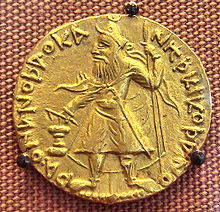Sho (letter)
 | ||||||||||||||||||||||||||||||||||||||||||||||||
| Greek alphabet | ||||||||||||||||||||||||||||||||||||||||||||||||
|---|---|---|---|---|---|---|---|---|---|---|---|---|---|---|---|---|---|---|---|---|---|---|---|---|---|---|---|---|---|---|---|---|---|---|---|---|---|---|---|---|---|---|---|---|---|---|---|---|
|
||||||||||||||||||||||||||||||||||||||||||||||||
| History | ||||||||||||||||||||||||||||||||||||||||||||||||
| Use in other languages | ||||||||||||||||||||||||||||||||||||||||||||||||
| Related topics | ||||||||||||||||||||||||||||||||||||||||||||||||
| ||||||||||||||||||||||||||||||||||||||||||||||||
The letter ϸ (sometimes called sho or san) was a letter added to the Greek alphabet in order to write the Bactrian language.[1] It was similar in appearance to the Anglo-Saxon and Icelandic letter thorn (þ), which has typically been used to represent it in modern print, although both are historically quite unrelated. It probably represented a sound similar to English "sh" ([ʃ]). Its conventional transliteration in Latin is ⟨š⟩.[2]

Coin of king Kanishka, with the inscription ϷΑΟΝΑΝΟϷΑΟ ΚΑΝΗϷΚΙ ΚΟϷΑΝΟ (Šaonanošao Kanēški Košano): "King of Kings, Kanishka the Kushan".

Bactrian Ϸ in three different historical writing styles,[1] and in a modern font.
Its original name and position in the Bactrian alphabet, if it had any, are unknown. Some authors have called it "san", on the basis of the hypothesis that it was a survival or reintroduction of the archaic Greek letter San.[3]
Other representations of [ʃ] in the Greek alphabet
This letter ϸ closely resembles, perhaps coincidentally, the letter ⟨